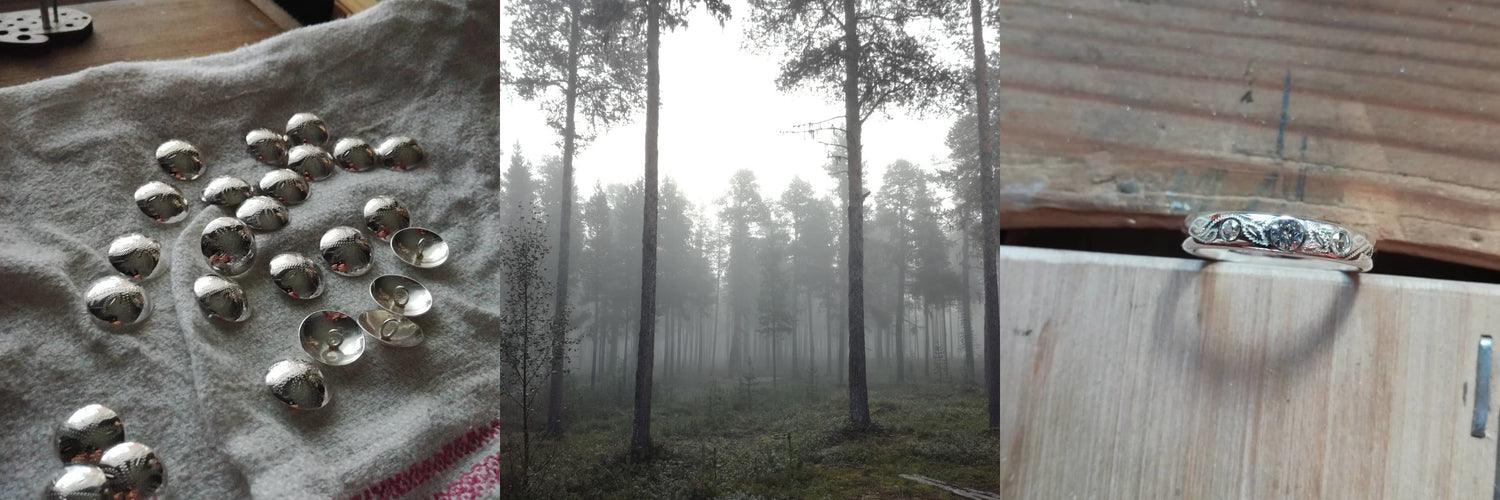Jewelry care
Read here how to keep your jewelry sparkling and in good condition for as long as possible.
Handling silver jewelry
The main material of our jewelry is Sterling silver, i.e. 925/1000 silver. It is softer to work with and tarnishes a little more slowly than the other common purity in the North, 830. Despite this, silver jewelry will tarnish sooner or later.
You can slow tarnishing by handling them correctly: avoid touching them with your fingers as much as possible. Oils from your fingertips have the effect of accelerating tarnishing. Grab hooked earrings only by the hook.
We handle finished, shiny jewelry only with cotton gloves in the store.
Washing jewelry
For the reasons mentioned above, you should keep your jewelry clean. Hot water and dishwashing liquid work well, but don't scrub the jewelry with anything. At home, soapy water will clean the jewelry by itself, if the water is hot enough. Do not submerge antler parts in water, at least not in hot water! In the workshop, we use an ultrasonic cleaner to maximize gentleness and efficiency.
There are differences in detergents. Avoid soaps that contain ingredients for treating hands or surfaces. They can leave a visible film on silver. My father Petteri says that the green Fairy Original darkens silver. Without researching the matter myself, I have been using the yellow Fairy for years, which is an excellent grease remover and works well.
Drying jewelry also requires care. A piece of wet jewelry left on the table may leave spots where the water droplets dry out. They can be difficult to remove by only washing. You can press the jewelry gently dry with a soft towel or paper, but do not wipe the jewelry dry. It will scratch the piece.
In the workshop, finished jewelry is dried in hardwood dust. For example, a sufficiently fine smoking dust is suitable for this purpose. Conifer dust cannot be used due to their resin content.
Storage of silver jewelry
Silver jewelry should be stored in airtight containers, e.g. in resealable plastic bags. As long as you make sure the jewelry is dry. All kinds of boxes, chests and cabinets also reduce air circulation on the surface of the jewelry, which slows down tarnishing. One excellent storage method is the freezer, but in this case you have to take into account the condensation of moisture on the surface of the jewelry when the cold piece is taken back to the warm air again. The freezer is especially suitable for belts, from which removing silver buttons for cleaning is tedious.
I got hairspray on my jewelry!
Take off the earrings before applying hairspray. Hairspray will also fall on a worn brooch, so I recommend putting on brooches and preferably dressing up after hairspray. Men's clasps are sewn on to the dress, so for them it is first hair, then the dress. Most hairspray lacquer does come off with washing, but this should be avoided, especially with jewelry containing antler pieces. If something has stuck to the jewelry, which does not come off with hot water and dishwashing liquid: you can gently try a cotton swab and acetone. However, do not rub the surface vigorously. The swab is not rubbed, but the acting substance is carefully applied on the surface. Note that most acetone-based nail polish removers contains also oils that have to washed off separately. Pure acetone is very volatile and will evaporate completely off the surface. In the case of clasps, one can rinse it the same way, using a water-soaked swab.
A caution on polishing with paste
A stubbornly common bad advice is to use toothpaste to clean jewelry. It contains abrasives. The scratches may not seem big, but in any case the paste wears away the fine silver (a very thin layer of pure silver) surface that protects the jewelry from tarnishing. Pastes intended for polishing silver also often contain abrasive substances. These and toothpastes should be saved for polishing already scratched table silverware, for which they are intended. All rubbing and wiping accelerates tarnishing of the jewelry in the future. There are liquid silver baths to remove oxidation from jewelry without rubbing.
When to a professional?
Silver jewelry stays shiny for years if properly cared for and kept. If there is a lot of tarnish (oxidation), just soaking in silver cleaner may leave the surface cloudy or white. This is due to the fact that some of the molecules on the surface have dissolved away and the surface is porous on a microscopic level. Tumbling the piece with steel shot and polishing liquid restores the jewelry's shine. Go to the maintenance page.

